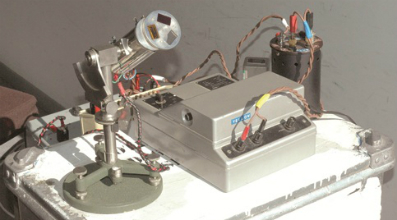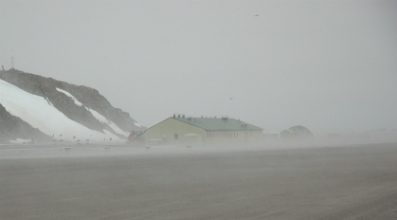These are exactly the conditions required to make observations of solar radiation, and one piece of equipment that I had to commission was a Kipp & ZonenPOM-01 sky radiometer, which automatically tracks the Sun, taking observations of the solar intensity every five minutes through a series of filters.
 We had purchased this to replace the old Angstrom pyrheliometer, which had not been calibrated for decades. In addition it took dedication from the observer to produce results, as a single observation needed many adjustments and the readings could take half-an-hour to complete. As a consequence observations had been made relatively infrequently at Rothera, and indeed most of them were made during my occasional visits.
We had purchased this to replace the old Angstrom pyrheliometer, which had not been calibrated for decades. In addition it took dedication from the observer to produce results, as a single observation needed many adjustments and the readings could take half-an-hour to complete. As a consequence observations had been made relatively infrequently at Rothera, and indeed most of them were made during my occasional visits.
Data from the instruments is used to compute atmospheric turbidity values, a critical variable when simulations of the climate are being run. It was just as well that I took the opportunity to start measurements on my arrival, as the next comparable spell of weather was shortly before my departure at the end of February.
The results from my observations were good, but in the end I decided that the Angstrom would need to have its final calibration at the World Radiation Centre in Davos, Switzerland.
January and February is the height of the Antarctic summer season, so not surprisingly weather conditions during my stay at Rothera were fairly benign.
We had a few days with gale-force winds, but the coldest temperature recorded at the station was only -3 °C, several degrees warmer than the coldest recorded at the BAS base in Cambridge during my absence.
We quite often get interesting weather phenomena at Rothera, and the most unusual during my stay was a display of steam fog, which occurred on a day of light rain from very thin altostratus, which allowed a lot of solar radiation through.

Overall the average temperature was just above freezing, and this combined with the high solar irradiation meant that there was considerable ablation of the snow surface. By the end of my stay it was quite noticeable that some of the relict ice covered areas were significantly lower than in past years.
In particular, one area, which used to form an ice-dammed pond each summer, remained dry because the ice level had dropped to such an extent that water could flow over it. It is just as well we now produce fresh water by reverse osmosis as this was the source of summer fresh water when I first stayed at the station.
Article by Jonathan Shanklin, British Antarctic Survey